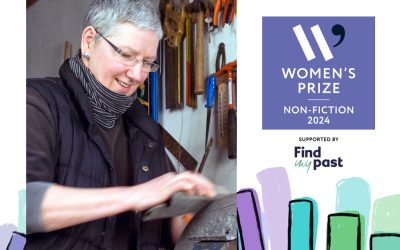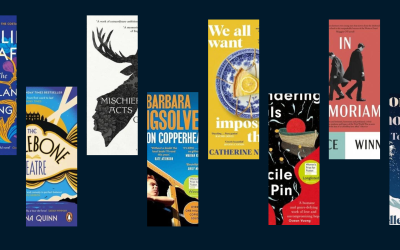
How to pitch your novel
Preparing to Pitch: The novelist salesperson “Can you summarise your novel in a sentence or two,” my marketer, Eloise asks,…


Are you taking part in the #ReadingWomen challenge, to work your way through the backlist of winners in celebration of the 25th anniversary of the Women’s Prize for Fiction? Or are you just looking for inspiration to sit down and start writing? Perhaps you’re using our new Discoveries programme to motivate you? We’ve got plenty of writing prompts to get you going based on the 24 former winners of the Prize – there are lots of different ways to get started.
A Spell of Women by Helen Dunmore (1996)
Inspired by Helen Dunmore’s beautiful and original descriptive writing about nature, write a short piece about a place familiar to you – a garden, park, beach or forest – in a particular season. Winter is paramount in Dunmore’s novel and lends a definite threatening feel to the novel; how does summer, spring or autumn change the environment and the feeling of your special place? You could write about the place in question every month or at every season, building up four or more pieces of description. See if the seasons provoke different moods and try to capture that mood in your writing using sensual detail and original similes and metaphors.
For a more in-depth project, find a local stately home or house of historical significance and research it as much as you can. Then, when you feel you know a lot about it, try writing a gothic period piece set in it. You could refer to the actual families that lived there (and perhaps a real scandal) or make one up, but endeavour to use all the gothic tropes you can: foreboding feel, a mysterious house, perhaps a madwoman (or man) in the attic . . .
Fugitive Pieces by Anne Michaels (1997)
The Holocaust is a tremendously emotive subject. Write about what it means to you. How do you feel about it? Even if you aren’t directly connected to the Holocaust by family or friends, you might say that all people are connected to every tragedy of this kind by virtue of our humanity. Even if it’s just a journal entry, acknowledge the fact of the Holocaust and record your feelings about it. Just by doing this small thing, you honour the millions lost with your remembrance and thoughts.
One of the most famous books about the experience of Jews in Nazi Germany is of course The Diary of Anne Frank. If you could write a letter to Anne telling her about some of the good things that happened in the world after the war ended, what would you write about? What would you say to Anne? What would you promise to do in the world now to promote tolerance and love for our fellow humans?
Larry’s Party by Carol Shields (1998)
Write a short essay about a woman from history or the present day, imagining it included in Beth Prior’s book about early women saints, Happy Enough. Who would you write about? Who do you consider worthy of sainthood?
Or, for something different, write a fairy tale about a maze, or featuring one. According to the Ancient History Encylopedia,
“Labyrinths form a visual counterpart to the epic folk-tale which often consists of a long and convoluted journey with episodes that repeat and double back on themselves. They may symbolise a journey of self-discovery too, a journey in to the centre of the self and out again and, in this way, the ancient symbol emerges as a Jungian archetype: a tool for self-exploration and healing.”
You could watch the 1986 film Labyrinth or Guillermo Del Toro’s Pan’s Labyrinth for inspiration, or remind yourself of the Greek myth of Theseus and the Minotaur. Will your fairy tale involve some sense of self-discovery for your character, as Shields does with Larry and his mazes?
A Crime in the Neighbourhood by Suzanne Berne (1999)
Imagine you are a newspaper reporter and write a story based on the news that Marsha has accused Mr Green of being the murderer and rapist of Boyd Ellison. Will you be sympathetic to Marsha, or cynical about her ‘evidence’? Will you make assumptions about Lois’ mothering skills (or Marsha’s parents being separated) as somehow relevant to the piece? Will you choose to comment on the fact that Boyd was not particularly well liked in the community? Will you choose to write a sensitive and well-researched piece or a splashy tabloid take?
Alternatively, is there a way to work out who killed Boyd Ellison? Go back through the book and make a diagram or mood board, using all the available information. Who could have done it? Who is the most likely suspect in a child murder?
When I Lived in Modern Times by Linda Grant (2000)
Write a manifesto for a fictional (or real) activist or political group. Look at examples of manifestos online for political parties, art groups like Dada and the surrealists, feminist groups, etc.What is their language like? Can it be almost poetic at times?
Alternatively, inspired by the Bauhaus design of Tel Aviv in the 1940s, research some local architecture and think about how it reflects the ideals of its time. You might like to write a poem inspired by a particular building or even a series of poems inspired by different buildings in your town, village or city.
The Idea of Perfection by Kate Grenville (2001)
Harley Savage’s craft work is patchwork, a lovely metaphor for healing: Harley is making something new and beautiful from the leftover scraps of other things. Douglas and Harley themselves could be considered other people’s rather unlovely ‘leftover scraps’ who, nevertheless, find love with each other.
Find a good selection of text sources you don’t mind damaging, like a few old books, magazines, and so on, and cut them up so that you can ‘patch’ them together into something new. Juxtaposing bits of text next to each other gives unexpected combinations: see what you get! A theme might suggest itself straightaway, or you could decide to impose a theme and look for the words you need. Cut out the parts you want and stick them onto a blank page in a way that pleases you. Have you made a poem, a statement, a story, a manifesto? See what happens when you vary your source text. Does your next piece change?
For a big project, make a patchwork quilt which somehow represents love, healing and unity. In many traditions, patches can often include embroidering words onto the quilt, so you could consider adding on text in some way onto yours – names, quotes that have meaning for you, dates of birth and death of loved family members, etc. A quilt can be a kind of documentation of a life or a family, but it could also record an important event or even something in the news you want to draw attention to, so decide what or who you want to document, and be creative!
Bel Canto by Ann Patchett (2002)
Listen to a piece of opera, perhaps one of the arias described in the novel, and write a poem or short descriptive piece inspired by it. What emotions does it evoke? Could you attribute colours, smells, tastes and textures to what you hear? Don’t censor yourself too much – let the associations flow, perhaps as you listen to the piece of music and make some abstract notes, then use those notes to craft your poem or other form of writing. If the music evokes some specific memories for you too, then use them.
For something more in-depth, research the story behind one opera. Get the main beats of the story – the type of characters, the main events, what the dramatic climax is – ie a death, coming together of lovers etc – and use them to write a short story (or something longer). You can see modern examples of where this has been done with Shakespeare plays like The Taming of the Shrew in the movie Ten Things I Hate About You or with Jane Austen’s Pride and Prejudice in Bridget Jones’ Diary. Think about what modern solutions or types of characters could replace the ones in whichever opera you choose. Have fun!
Property by Valerie Martin (2003)
Choose a scene from the book – possibly the rebels attacking the house, Charles’ funeral or Sarah plotting her escape – and write it from Sarah’s point of view. Sarah’s point of view will be a nuanced one: she is a slave and the mother of two of her slave owner master’s children, as well as a woman subject to sexual abuse. How might her feelings toward her children affect her decision-making? How does Sarah feel about Manon’s husband, and what does she think of Manon herself? Do any of these events make Sarah feel free? Is it possible for Sarah to be free?
Alternatively, you could write some unsent love letters from Joel to Manon, or imagine a romantic correspondence between them. Joel is restricted by money and can’t afford to get romantically involved with Manon, but there is an obvious chemistry there. Given that we don’t really have sympathy towards either of them, can you write convincing love letters between two reasonably unpleasant characters? How would Joel’s ‘voice’ come across on paper? How would Manon address him in letters? And, would things stay reasonably polite, or get very suggestive?
Small Island by Andrea Levy (2004)
Research the 1924/1925 Empire Exhibition, attended by Queenie at the beginning of Small Island. Write a piece from the point of view of one of the participants, whether a beauty queen taking part in the ‘Pear’s Palace of Beauty’ or an exploited native person from one of the then-British colonies. How might a person being ‘exhibited’ feel about being stared at as an object of curiosity, or something worse? How might they feel about London, about being part of the British Empire? How did they get to the Exhibition? How do they feel about the appearance of the pavilion attributed to their homeland?
Research Jamaican novelists and poets. Read their books, and research British colonial history. What didn’t you learn about at school or in further or higher education? Whose voices have been left out of the ‘canon’ of English Literature?
We Need to Talk About Kevin by Lionel Shriver (2005)
Write a letter from Franklin to Eva from any point in the book – it might respond directly to one of the letters Eva sends, or be a more general reply from Franklin. Where is he? What will he say to Eva? Does he still love her? How does he feel?
You might also like to write a number of letters from Franklin either to Eva or to someone else: a friend, relative, or someone else like a doctor or professional contact. What is their relationship like? How does Franklin express himself with them? Is he different to the way Eva depicts him? You can choose to make him sympathetic for a reader (or really irritating, if you like!). You could add in details about Thursday that don’t appear in Eva’s account, or details about Franklin’s life with Kevin and Eva, or even about Franklin’s childhood.
On Beauty by Zadie Smith (2006)
Write about a piece of music of your choice that represents a personal journey of some kind, inspired by Kiki Belsey’s time at the concert. Is there a piece of music that represents a particular time or memory for you, or suggests some kind of life event?
As a bigger project, write a family history of your family, starting perhaps with parents or near relatives and working backwards. What were their views, their politics, where did they live, what did they do?
Half of a Yellow Sun by Chimamanda Ngozi Adichie (2007)
Use the title The World Was Silent When You Died as the inspiration for a poem. Who or what will be the focus of your piece? Who has died? Your poem may be about a group of people in history, someone in current times or someone you knew personally. Why was the world silent when they died? It may be that you interpret this as a reverential silence, or a silence which was bad because nothing was said or done.
If you were writing a non-fiction book about modern British politics, what would you write about and how would you write about it? You might, for instance, try and write a non- fiction piece explaining Brexit, which in its own way might be seen as a move towards independence. You might like to write a number of short segments like the text from The World Was Silent When We Died.
The Road Home by Rose Tremain (2008)
Write the transcript of a phone conversation between two friends or lovers, each in a different country. Try to show – and not say specifically – a tension between the two people, being restricted only to what they say. You can’t use any description here; just be limited to the actual words that are spoken, back and forth. See if you can hint at a secret, a bone of contention or something that isn’t fully talked about, just something tense that the characters hedge around.
In Poland there is a traditional art of papercutting: carefully cutting out intricate figures and scenes to create art and animation (you might look at the art of Polish children’s author-illustrator Jan Pienkowski to get an idea). Have a go at making a scene using papercutting, perhaps from a fairy tale. Make it as intricate as you like!
Home by Marilynne Robinson (2009)
Write a short story or poem titled home is where the heart is. You might like to base it on memories of your childhood home, write it about your current home or even an imagined, utopian home that would make you happy. How do you convey the emotion of home? And is that emotion happy, cosy, sad, cold, lost, confused? You might describe one item as being integral to the way your home feels. What is it and what does it represent.
Jack and Glory’s stories are both sad ones, though they find solace in getting to know each other as adults. Is there a sad story in your family history that needs to be told? Is there something in the telling of it that releases it, gives it a new life or puts it peacefully ‘to bed’? Talk to older relatives or family friends and see what old stories they can tell you – you might be surprised!
The Lacuna by Barbara Kingsolver (2010)
Frida Kahlo is famous for her self-portraits. Draw or paint yourself with no judgement. Kahlo famously disliked most of her body (she didn’t mind her eyebrows, but there wasn’t much else she liked about her face, and she thought her head was too small), so in these days of body positivity, be kind to yourself and your image.
If you’d prefer not to paint or draw, you could take a selfie of yourself and label it using the mark-up tools on your phone or computer. Remember: be kind, as if you were labelling your dearest friend’s photo. Notes could include your happy smile, laughter lines and sparkling eyes.
Alternatively, write a poem inspired by one of Frida’s paintings, such as Self Portrait (1940) or Tree of Hope (1946). Most of them have a magic realist element to them so they’re perfect for creating unusual juxtapositions and strong imagery. See if you can convey the mood of the painting. Describe the fantastical elements interwoven with what you know of Kahlo’s lived experience using rich metaphors.
The Tiger’s Wife by Tea Obreht (2011)
Natalia says that the key to her grandfather’s life and death “lies between two stories: the story of the tiger’s wife, and the story of the deathless man”.
We all tell ourselves stories about our own lives, both framing the past in particular ways that may suit the way we live our lives now, and telling ourselves the stories of what we believe are likely to happen to us in the future. Those ‘stories’ pattern our lives, yet they are probably only versions of truth.
Especially when it comes to the past, the further we get from it, the more difficult it might be to know the truth. Examine one of your own early memories. Write down as much detail as you can about it. If there is a particular feeling attached to the memory, note it, but then rewrite the memory with a different emotion attached to it. Write the sad memory as if it was happy, the happy as if it was sad, etc. If it’s a memory of anticipation, make it about dread and vice versa. Keep theactual events true, as you remember them. How does doing this make you feel?
For something more in- depth, keep a memory diary. At regular intervals, write down one memory at a time as fully as you can. Each time, challenge yourself to feel it and remember it as clearly as you can. Try and estimate your age at the time the event happened and note that down. You don’t have to remember things in order, just one memory from any time, every time. In fact, it’s interesting to observe what your strongest, most vivid memories are: they may be memories from childhood or something more recent and/or difficult that you are still processing. You might want to set aside a special notebook
just for this purpose. In the process, do you find memories you thought you’d forgotten?
The Song of Achilles by Madeleine Miller (2012)
Find a Greek myth you like (or don’t like very much!) and rewrite the main bones of the story from a minor character’s point of view. How does it change the story? How does the minor character feel about what happens? They might perceive things very differently indeed.
The Trojan Horse is such an iconic idea now that we use it in conversation as a widely understood concept rather than part of a story. Find another intriguing turn of phrase that you don’t know the history of, and write a story that in some way expresses what you think might be the concept or history of the phrase (or, look it up, and use the actual reason as inspiration for a story). Here are some odd British-isms you might use:
May we be Forgiven by AM Holmes (2013)
Jane’s is a voice we hear all too little from in this novel due to her death early in the narrative; consider writing a few days’ worth of entries from her diary. Is she planning to leave George? How does she feel about the children being away at school? Does she worry about the effect a divorce would have on them? Perhaps you could show Jane planning Nate’s bar mitzvah – or write about her feelings for Harry.
For a more involved project, write accounts of the experiences of four of George sexually harassed at work, as the women first-person narratives. Are their experiences similar to each other or different? What did George do to them and what was their response? Do they manage to get any closure or revenge on George? Is their workplace sympathetic to them or does it attempt to cover things up? What are the women’s feelings when it becomes known that George has murdered his wife? Do they form a survivor’s/victim’s group of some kind?
A Girl is a Half-Formed Thing by Eimear McBride (2014)
Think of a title that makes a statement about girlhood, like A Girl is a Half-formed Thing. So, perhaps yours could begin A Girl is . . . and then fill in the gaps according to your thoughts – or you could use a completely different structure. Then, write a short story that somehow explores girlhood according to the way you have described it in the title. What do you want to say about girls? What was important to you as a girl or as a teen?
Sex is a subject we don’t often see in literary novels in as much detail as we do in A Girl is a Half-formed Thing. Write a story about sex. You can draw on your experiences, or imagine something more in the realm of fantasy. Is it difficult? How detailed will you be? Consider the emotions, the mental process as well as the physicality. What relevance does sex have in the story? How do the characters experience sex – positively, negatively, ambivalently? Why? What’s their backstory?
Will you use a particular style to write this story? Even choosing a point of view character or a past/ present tense will have a strong effect on the finished story.
How to Be Both by Ali Smith (2015)
Describe a famous painting or sculpture, either find it online or go to a gallery or space and describe it as you see it. Be as detailed as you can, and describe what you see, rather than using any previous knowledge about the work. Note the colours, expressions, textures, smells or even tastes you associate with it.
There’s no right or wrong interpretation; be as thorough as you can in connecting with the artwork and noting what it means to you. Then, find out its given meaning or theme – either what the artist intended or the popular interpretation of the work. Does it change how you perceive it? Which interpretation do you prefer?’
For something extra, experiment with observing the people around you at a gallery or space where there is artwork. Observe them looking at and talking about the art. Write about two different people’s observations, or what you think their thoughts might be looking at the art. Maybe intersperse their thoughts into one descriptive piece told by two voices. Does doing this make you see the artwork differently?
The Glorious Heresies by Lisa McInerney (2016)
Ryan writes a little about his experience of prison in his letter to Karine, but purposefully doesn’t say much, though he narrates more of it later. See if you can write what you think might have happened to him there. What might his day look like? How might he feel, hour to hour? He says he reads; what does he read and what does he think of it? What does he eat? Who does he interact with? Write perhaps just a 1000-word excerpt from Ryan’s time in prison and try and make it as fully imagined as possible.
Lisa McInerney’s writing sings with brilliantly observed language, turns of phrase and humour specific to Cork in Ireland. Write a passage of dialogue between two characters using a local dialect or accent you’re familiar with; it might reflect the place you live now or somewhere you’re very familiar with. Include aphorisms, words specific to that region, ways of phrasing sentences and see how you can depict an accent on the page.
The Power by Naomi Alderman (2017)
Inspired by Allie/Mother Eve’s retelling of biblical texts to suit her own purposes, find a religious story from any tradition and rewrite it from the perspective of a female character you feel might be misrepresented within it (or not included at all). What does she want to say about her treatment in the story?
Alternatively, imagine that patriarchy ‘won’ the war: how might the men’s rights activists groups write about Roxy Monke and Mother Eve? Write a tabloid article, complete with a suitably worded headline and byline, describing either of them at trial or their ‘bad deeds’.
Roxy Monke is a brilliantly rounded character. Consider writing a piece of crime fiction featuring Roxy, perhaps in role as a police detective after giving up a life of crime. How might she differ or compare to other fictional female detectives? Study women detectives in a range of crime fiction to inform your writing, starting with Denise Mina’s Alex Morrow or Tana French’s Antoinette Conway.
Home Fire by Kamila Shamsie (2018)
Taking the title as inspiration, write about what the words Home Fire mean to you. Is it about a sense of the warmth and belonging of home? Is it about a tragic event? Is it about a pensioner struggling to pay the heating bills? Whatever your immediate associations, write as freely as you can for fifteen minutes, putting all your ideas down quickly and without self-censoring. You might want to set an alarm so you know when the time’s up. In that fifteen minutes, don’t take your pen off the page and don’t stop writing.
For a more involved task, write about your father, or someone who has been like a father to you. What are they like? Describe their personality, what they look like, their posture, their likes and dislikes, what they’ve done with their life. How has their family, their community, their culture influenced their life, if at all? Write about what they’ve taught you, or not taught you. What do they care about? What are they immune to caring about? Who do they love? Who have they loved? Do you love them? Is this something that, when you’ve written it, you will want to give to them? Or not?
An American Marriage by Tayari Jones (2019)
Inspired by Celestial’s ‘dolling’ you might like to research the art of contemporary women of colour or contemporary ‘folk’ artists. Pull together a Pinterest board or a blog featuring your favourite finds: think about common themes, techniques and even materials, and why those might be used.
Alternatively, An American Marriage features a dual narrative, told respectively by Celestial and Roy, with occasional interceptions from Andre and Roy’s father, Roy Senior. Think about writing one of the scenes from a different point of view we don’t hear from: perhaps the woman in the motel that Roy helps out can retell the events from her point of view, including or excluding the attack. What sort of person is she? What happened from her point of view?
We hope these writing prompts sparked inspiration! Find out more about our #ReadingWomen challenge here>

Preparing to Pitch: The novelist salesperson “Can you summarise your novel in a sentence or two,” my marketer, Eloise asks,…

Thrilled to annouce today the winning artist nominated to create ‘The Charlotte’, the figurine to be cast in bronze which…

The best recommendations come from readers, so we asked YOU to tell us the stand-out books by women you read…

There is nothing better than settling down with a good book and escaping the mundane, everyday life. Books are where…
Tune into host Vick Hope and a line-up of incredible guests on our weekly podcast full of unmissable book recommendations.
